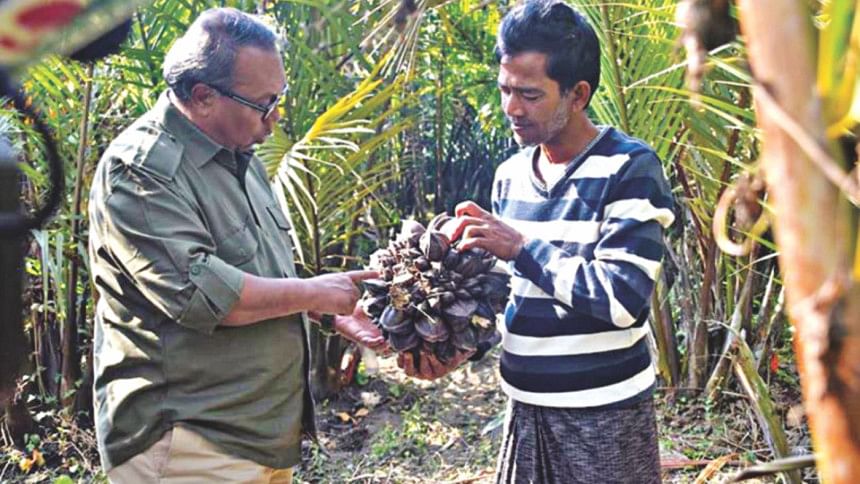Heritage of coastal Bangladesh

The southern part of Bangladesh is blessed by nature and its resources. A few days back, I went to Nilganj union of Kalapara upazila in Patuakhali. A village named Nabipur there is famous for golpata (nipa palm) juice and gur (molasses). We can take pride on it as it's one of the most important heritages of our southern Bangladesh.
Nipa palm serves as the livelihood for many farmers of Nabipur, a village famous for low land farming, apart from paddies on the highlands and flat fields.
Golpata in Bangla means round leaves (gol means round, pata means leaves). But gol, a common tree in the coastal areas, is a distinct type of tree with leaves similar to coconut trees. It grows abundantly by the canals of southern region of our country. And this crop thrives in saline water. Many countries in the world have nipa palms in their sea coasts.
For decades, this tree has strengthened our agricultural economy, being inseparable with the lives of the people in the coastal area.
Nipa palms grow naturally, but many people here have made it their livelihood support. I met a farmer named Nirmal Chandra Mridha at Nabipur.
"We just don't get juice and molasses from nipa palm. We make roofs of our houses with its leaves. We also make fences with the leaves," said Nirmal.
Certainly, it is very useful for different kinds of household needs.
The nipa juice is collected during the Bangla months of Agrahayon, Poush, Magh, Falgun and Chaitra.
"How much do you earn by collecting juice from the trees in these five months?" I asked Nirmal.
"I get 12 kg of molasses daily. This year, the price is high. It is 70-80 taka per kg."
"So, you earn about a thousand taka daily for five months."
"Yes", was his reply.
A local farmer was saying his nipa orchard is 50-60 years old. If you plant one, it gradually expands.
Dear readers, there is barely any home where you won't find nipa farming in Nabipur village. They collect nipa juice, make molasses and sell at the nearby market.
I went into Jagadish Chandra Sarker's home where nipa juice was being boiled.
I had a little talk with the veteran nipa farmer.
"Nipa farming is going on for generations and I am proud that my son Uttam and I could carry this heritage on," said the proud nipa farmer Jagadish.
Jagadish gave me a brief on the advent of nipa palm in the region.

"Once the Burmese (people from now Myanmar) used to come here and they first started this. They used to store the juice in chonga and make tari, an intoxicating item," said Jagadish.
"Later on, who started making molasses?" I asked Jagadish Chandra.
"Our ancestors," boldly claimed Jagadish.
Uttam's wife Dipali was busy in boiling the nipa juice. This process takes a long time. She's really expert in this job.
"How much of raw juice are you boiling today, Dipali?" I asked her.
"60 kg," she replied.
"How much molasses would you get from this?" I asked.
"15-16 kg," she replied.
It will take her an hour or so to boil up the juice to make molasses. Keeping her at work, I went to have a look around the village.
I found sundari trees in some parts of the village. There were some paddy fields. Uttam showed me how they collect raw juice from inside the orchard.
They massage one branch of the tree by bending it. For seven to eight days they do it. After that they cut the mouth open and juice starts dripping on the pot. They keep on cutting the mouth of the same branch for seven days. The process seems quite interesting.
Uttam can't harvest juice on his own from his huge orchard. He sells nipa juice to others, to be extracted from trees on half of his orchard by the buyers themselves.
"How much do you sell a tree for?"
"60 taka each."
"What about cultivation cost and agricultural inputs?"
"There is hardly any expense for cultivation and maintenance," Uttam replied.
Farmers are really afraid of the bees inside the orchards. That's the main obstacle they face, but they tackle it somehow.
As per a local tradition, farmers don't take the juice home on the first day. They make payesh with the juice and put it at the foot of the tree for mama, a term they fondly use to mention foxes. Respecting these foxes means protecting their orchards, as they believe.
Local farmers want nipa farming and cultivation of other crops to go on simultaneously. We know nipa farming needs salty water while the mainstream crops don't.
"I think, if agriculture department arranges digging canal in a planned way, nipa palms can be cultivated with the help of salty water and the flat lands above can be used for general farming. In that case, both can be benefited," says Nasiruddin Mahmud, chairman of the Nilganj union parishad.
Meanwhile, Dipali's gur is ready. She didn't pour sugar in it to make it hard, unlike many others who do it to make khejur gur (date juice molasses) hard. It was really tasty and I must say, dear readers, you would like to try the gol gur, after reading this article.
Dear readers, nature sets grounds for distinct livelihood patterns of each locality. A good part of the life of this region centres round the nipa molasses. It is a great part of our heritage. We should be able to preserve these traditions. At the same time, we need to dig canals and build embankment in a planned way to help the people of this area to keep nipa orchards alive and preserve the tradition of nipa juice. For this, we need to make agricultural development plans based on visionary ideas for survival and growth of the great heritage of this region.

 For all latest news, follow The Daily Star's Google News channel.
For all latest news, follow The Daily Star's Google News channel. 



Comments